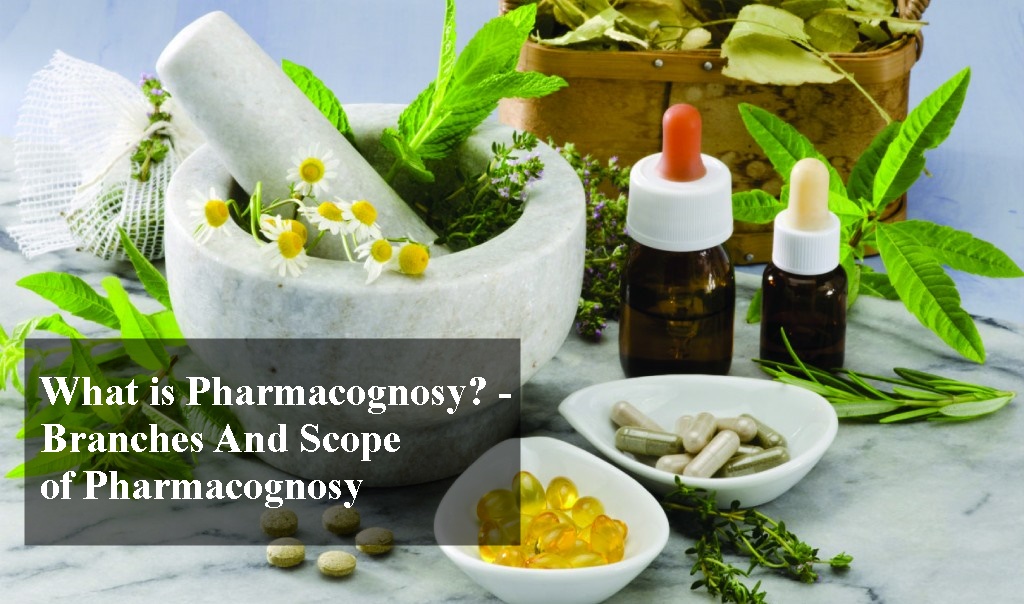From Wikipedia – Pharmacognosy is the study of plants or other natural sources as a possible source of drugs. The American Society of Pharmacognosy defines pharmacognosy as “the study of the physical, chemical, biochemical, …

It means the harvested and usually dried plant or animal sources of pharmaceutically or medicinally useful products before they have undergone extensive processing or modification. Crude drugs are from the mineral, vegetable, and animal kingdoms. Crude drugs of vegetable, animal, and mineral origin form the subject matter with which pharmacognosy is concerned.
Meanwhile, we still have a lot we will be talking about on this page please you can feel free to ask a question any time using the comment box or the form below:
What is Pharmacognosy?
Pharmacognosy is a branch of Pharmacy that focuses on the discovery of new drugs from natural products. According to the American Society of Pharmacognosy, It is defined as “the study of the physical, chemical, biochemical and biological properties of drugs, drug substances or potential drugs or drug substances of natural origin as well as the search for new drugs from natural sources”.
Pharmacognosy is from two Greek words: “Pharmakon” and “Gnosis”. The word Phamakon means “Drug or Medicine” while Gnosis means “Knowledge”. Therefore, the study of Pharmacognosy as one of the Departments of Pharmacy education focuses on information about drugs from natural origins.
Importance of pharmacognosy
There is a serious need to develop novel and safer drugs of natural origin. It is of importance to mention the degree to which microorganism forms resistance to our conventional and orthodox drugs in circulation.
Many years ago, in the apothecary model of pharmacy practice, the physicians or pharmacist makes their drug recipes from plants and other natural substances. Also, traditional medicine practice was remarkable and acts as the people’s hope for healing in many developing countries.
The identification, determination of purity, standardization, ethnobotany, and other scopes lies on the shoulder of pharmacognosy for survival.
Therefore, pharmacognosy is a hope to identify and innovation of new drugs, the documentation and standardization of the already available ones, and the study drugs as used by different ethnic groups.
Drugs of natural origin are easily accepted because it is organic and therefore can be easily metabolized by the body. It is also cheap and readily available.
Scope of Pharmacognosy
The scope of pharmacognosy covers a very wide area in the pharmacy profession. Therefore, it is beyond just a study of drugs from natural sources but also includes the steps in their processing and identification.
Below is a list of some topics in the pharmacognosy.
- The Sources of natural drugs
- Cultivation, collection, and storage of crude drugs
- Identification and Adulteration of crude drugs
- Extraction of active ingredients and purification
- uses and Documentation of the drug samples
- Determination of toxicity and safety profile
The sources of natural drugs
Natural drugs can come from four (4)natural sources which include; Plant, animals, minerals, and microorganisms. below are some examples of drugs of natural origin;
Plant Origin: Ephedrine from Ephedra sinica and Cocaine from Erythroxylum coca.
Animal origin: Glucosamine from shellfish and Enoxaparin from Pig.
Mineral origin: Ferrous sulfate and Kaolin.
Microorganism: Streptomycin from Streptomyces gracious and Penicillin from Penicillium notated
In addition, the study of pharmacognosy also extends to the habitats where these crude drugs are found and the geographical distributions. Some plants grow better in the tropics than in temperate regions, a common example is plants that survive better in the desert such as the cactus plant.
Cultivation, collection, and storage of crude drugs
Pharmacognosy also studies the factors that affect the cultivation, collection, and storage of crude drugs.
Cultivation:
The area of cultivation has to do with the Propagation of the crude drug – asexual and sexual propagation. Propagation studies the ways to improve the production of the drug without affecting the quality of the crude drug produced. Grafting, budding, cutting, and layering are common methods used in herbal drug production.
affect cultivation also takes into cognizance of the ideal habitat for growth and how climatic factors affect the growth of these natural drugs. The climatic factors include; humidity, annual rainfall, wind, light, temperature, and topography. In other words, these factors affect the geographical distributions of these crude drugs.
Collection:
The collection of crude drugs is very important and requires skills to avoid admixture or adulteration of the drugs collected. In the collection, care is taken to make sure you collect the right drug, the right part of the drug, and to collect at the most suitable time.
For example, if you are to collect the leaf of Amaranthus spinosus for analysis and you end up collecting a leaf from a similar specie such as Amaranthus hybridus or the root from Amaranthus spinosus. The result of the analysis is likely to be negative because of improper collection of the drug.
In addition, pharmacognosy also studies the timing for collection, for example, the Gum arabic popularly used in many pharmaceutical productions is best collected in the dry season. Also, the time of the day for collection plays an important role in the quantity and quality of the drug sample collected. For example, plants that contain volatile oils are better in the evening than in the day when the oils must have evaporated.
Storage:
After the collection of the crude drugs, the next step is to store them to preserve the integrity of the drug. The scope of pharmacognosy also covers these steps in storage and preservation.
The first step in the storage of a crude drug is garbling which means removing foreign materials and dirt from the crude drug. After the garbling process is the packing of the drug samples. Wrongly packed drugs lose their integrity easily. For example, The best pack for Balsam of tolu is kerosene tins while aloe is in goatskin.
Finally, preservation is also important in the storage of crude drugs. The method of preservation will strongly depend on the physical and chemical properties of the drug. Honey from bees is best preserved by refrigeration while stem backs of some plants are best when dried. Preservation of crude drugs also includes protection from insects and rodents.
Identification and Adulteration of crude drugs
Crude drug identification simply means ways to determine if the drug sample is from the right source and meets the standard of the same drug in the official books. Most times drugs are mixed with other substances or foreign materials unintentionally or intentionally by sellers to maximize gains.
Therefore, adulteration is the complete or partial admixture or substitution of a crude drug with another of an inferior standard.
The scope of pharmacognosy also ensures that these drug materials are identified and devoid of adulteration. The pharmacy’s official books such as Pharmacopoeias have standards to measure the level of purity of these substances. There are two ways to identify a drug sample, they are;
- Macroscopical evaluation
- Microscopical evaluation
Macroscopical evaluation: The macroscopical screening involves the organoleptic or the physical properties of the crude drug. Such properties are those you can feel with your sense organs such as touch, taste, appearance, and smell.
There are so many parameters used as a reference to identify the organoleptic properties of a drug such as; Types of fracture, shapes of bark, leave shapes, venation e.t.c.
Microscopical evaluation: These properties are those we can not feel with our sense organs but requires the aid of a microscope. Each crude drug has a unique property when viewed under the microscope. Some of the differentiating characteristics of crude drugs under the microscope includes; the no of palisades, the presence and types of trichomes, the shape of calcium oxalates, shapes of the stomata, etc.
In addition, some chemical properties of the crude drug may serve as a confirmatory test such as the ash value, the chemical constituents, moisture content, etc.
Extraction of active ingredients and purification
Crude drugs are not used in their natural form, there are substances present in the drug that makes it have a biological property called the active ingredients. In plants or herbs, they occur as a result of the plant’s end product of metabolism and are called secondary metabolites. Such products in plants confer additional properties that aid their survival and also are bioactive. Examples of such compounds include; Alkaloids, phenolic compounds, tannins, volatile oils, and flavonoids.
Nevertheless, these plants can be extracted through methods such as maceration, decoction, Infusion, percolation, and microwave-assisted extraction. Each method of choice will depend on the type of material desired.
Also, the constituents of the organic crude drugs can be separated through distillation, crystallization, and chromatography. The scope of pharmacognosy covers them all.
Uses and Documentation of the drug samples
The study of pharmacognosy also covers the area of knowing how people use plants and the diseases they treat with them. These branches of pharmacognosy are ethnobotany and ethnopharmacology respectively.
Most times, the problem with traditional medical practice is that those drugs of natural origin used by native healers are not properly documented. Consequently, the drug or the recipe dies with the herbalist or the traditional healer.
Therefore, pharmacognosy also tries to document these drug samples, especially in countries where more than half of the population depends on natural drugs. In the field of pharmacognosy, plants are pressed and preserved in a herbarium for reference purposes.
Determination of toxicity and safety profile
According to Paracelsus, all drugs are poisons, the difference between a drug and a poison is just the dose. The common problem with pharmacognosy is to determine the dosing of these crude drugs. Most times there is information with regards to toxic and safety concentrations of the crude drugs.
Therefore, there is a need to carry out in-vitro and in-vivo studies on the safety windows of these natural drugs.
Branches of pharmacognosy
Pharmacognosy can be types typed as the following branches; biosynthesis,
Ethnopharmacology
This branch of pharmacognosy has to deal with the study of the uses of crude drugs from an ethnic background. In other words, it simply means the actions of drugs,s as used by different localities.
Phytomedicine
The field of phytomedicine studies the efficacy, safety, toxicity, and pharmacological actions of crude drugs of plant origin. Phytomedicine also studies novel drugs from plants, their dosing, and methods of administration.
Phytochemistry
This field studies the chemistry of substances present in the plant. These chemical products are products of metabolism and also play a role in the biological activities of the drug.
Biotechnical drug production
In biotechnical drug production, technology is applied to the genetic makeups of living organisms for drug production. An example is the An examplerecombinaDNADNa technology for insulin production from E.coli.
Ethnobotany
Ethnobotany studies indigenous people and their general uses of plants. However, it is broader than ethnopharmacology since it only focuses on the therapeutic activities of the crude drug. But, ethnobotany studies other parameters such as habitat, cultivation, and other uses of plants by people in a locality.
Read More Here: Anabolic steroid abuse – Health implications & How to withdraw



